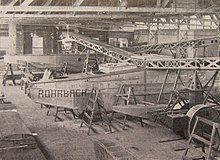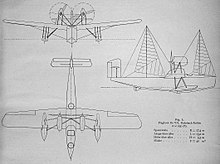Rohrbach metal aircraft construction
| Rohrbach Metallflugzeugbau GmbH
|
|
|---|---|
| legal form | GmbH |
| founding | 1922 |
| resolution | April 1934 |
| Reason for dissolution | Takeover by Weser-Flugzeugbau GmbH |
| Seat | Berlin , Germany |
| management | Adolf Rohrbach |
| Number of employees | up to 600 |
| Branch | Aircraft manufacturer |
The Rohrbach metal aircraft GmbH was a 1922 by Adolf Rohrbach in Berlin based company for the construction of advanced all-metal aircraft . At the same time, Rohrbach-Metall-Airplane Co. A / S in Copenhagen was created to circumvent the requirements of the Versailles Treaty .
Company history
Rohrbach, an experienced aircraft manufacturer who also taught at the Technical University of Charlottenburg , founded Rohrbach Metallflugzeugbau GmbH in 1922 with its headquarters at Friedrichstrasse 203, where only construction drawings were made and individual parts were built for the machines, which were then used in the factory in Copenhagen . That is why Rohrbach founded the Rohrbach-Metall-Airplane Co. A / S in Copenhagen for the construction of the machines and the final assembly of the aircraft. The first order was for the construction of ocean-going flying boats for Mitsubishi . Further orders came from the British Navy and for the Ro IIIa Rodra for the Turkish Navy. Twin-engine land aircraft and the three-engine Ro VIII Roland , the most successful commercial aircraft for Lufthansa , were created for the newly founded Lufthansa. Between 1922 and 1926 Rohrbach Metallflugzeugbau became the third largest German aircraft manufacturer.
From 1924 a production hall was built on the site of Kiautschoustraße 9-12 and Sprengelstraße 28-32 in the middle of a residential area in Berlin-Wedding that had previously belonged to the Norddeutsche Lagerhausgesellschaft. The choice of location was unusual in that it was far from any airport and offered no opportunities for expansion. It can be assumed that this was done for reasons of camouflage, since aircraft construction in Germany was then prohibited by the Treaty of Versailles . The company was not only involved in civil aircraft construction, but also tried to get orders from the Reichswehr Ministry. It is known that Rohrbach applied for a loan from the Reichswehr Ministry for the expansion of his aircraft factory as early as autumn 1923. He strove to collaborate with the Reichswehr with the intention of expanding the existing test facility in Berlin to a factory with 200 to 300 skilled workers. All types of aircraft, including military ones, were then to be manufactured in this plant. The plant in Denmark was to remain in place to circumvent the provisions of the Versailles Treaty. The aircraft factory was built on the industrial area based on a design by Werner March . The hall was 60 meters long and 46 meters wide. An office building was built on Kiautschoustraße to accommodate the construction department. In 1927, the factory building was expanded and bordered on Sprengelstrasse. The complex was demolished in 2004 and the Sprengelpark was built on its site .
In April 1934 Weser-Flugzeugbau GmbH took over the company. Adolf Hitler used a Ro VIII Roland rented by Lufthansa for his flight to Germany for the 1932 election campaign. In the ten years of its existence, the company produced a total of only 41 aircraft without any license builds.
Model history
The first construction built was the twin-engine Ro II flying boat designed for the Japanese Navy . This was followed by the Ro III and Ro IIIa Rodra , the latter of which was also exported to Turkey . The most successful design was the Ro VIII Roland , a three-engine airliner for 10 passengers. The company's only single-engine aircraft was the high-wing fighter Ro IX Rofix, which, however , was not pursued after the crash of the first prototype with the well-known pilot Paul Bäumer at the controls. The Rohrbach Ro X "Romar" was one of the great flying boats of its time . In order to get the aircraft to its place of use, it had to be dismantled into individual parts and transported through the narrow streets of the Sprengelkiez to the north port . From there, the parts were sent to Travemünde , where the sea test site was located.
“... The Rohrbach giant flying boat is the largest in the world. It weighs 300 ctr. The wingspan is 37 m, the hull length 22.70 m. It is equipped with 3 engines with a total of 2400 HP. The whole boat consists of 8 watertight pods like the ocean liners have, which in the event of an accident are completely sealed against each other and prevent the flying boat from sinking. "
| Sample flying boats, unless otherwise stated |
number of pieces | delivered to | in the year |
|---|---|---|---|
| Ro I | model only | ||
| Ro II | 2 | Japan | 1924 |
| Ro III | 7th | Japan | 1924/25 |
| Ro IIIa Rodra | 2 | Turkey | 1926 |
| Ro IV ( Beardmore Inverness ) | 1 | England | 1925 |
| Ro V Rocco | 1 | Germany | 1927 |
| Ro VII Seal I / II | 2 | Germany | 1926 |
| Ro VIII Roland I (land plane) | 9 | Germany | 1926/27 |
| Ro VIII Roland II (land plane) | 2 | Germany | 1928 |
| Ro IX Rofix (land plane) | 2 | Germany | 1926 |
| Ro X Romar I | 3 | Germany | 1929 |
| Ro X Romar II | 1 | France | 1931 |
| Ro XI Rostra | 2 | unsold | - |
successor
At the beginning of the 1930s, the Rohrbach company had to cease operations for economic reasons. It was taken over by Weserflug from Lemwerder in April 1934 . Rohrbach became technical director there. The factory in Wedding was initially continued as the "Rohrbach Plant", but from October 1936 it was gradually moved to Lemwerder, the plant became the property of the Bank of Deutsche Luftfahrt and was liquidated. Rohrbach Metallflugzeugbau GmbH was deleted from the commercial register on December 31, 1941.
literature
- Lutz Budraß : Rohrbach and Dornier. Two companies from the Zeppelin aircraft construction in the Weimar Republic and during National Socialism. In: Wolfgang Meighörner (Ed.): Zeppelins Flieger. The aircraft in the Zeppelin Group and its successors. Wasmuth, Tübingen 2006, ISBN 3-8030-3316-0 , pp. 202-235.
- Judith Hahn: From high-tech location to Sprengelpark. The story of an industrial area in Berlin's Wedding . [email protected], Berlin 2005, ISBN 3-00-016538-X ( architekt-wolf-berlin.de [PDF; accessed on March 25, 2017]).
- GJ Staalman: Dr. Adolf Rohrbach Chronicles. ADOLF KARL ROHRBACH 1889–1939 German airplane designer, entrepreneur. 2014, accessed on October 20, 2017 .
Web links
- Image and information ( memento of August 4, 2007 in the Internet Archive ) on geschichte.aero
- Pictures and information on eads.com ( Memento from December 2, 2008 in the Internet Archive ) (French)
- Drawings and further information (French)
- Early newspaper articles on Rohrbach metal aircraft construction in the 20th century press kit of the ZBW - Leibniz Information Center for Economics .
Individual evidence
- ^ Rohrbach metal aircraft construction . In: Berliner Adreßbuch , 1923, IV. Streets and Houses of Berlin, p. 288. “Friedrichstrasse 203; Rohrbach Metallflugzeugbau “.
- ^ Rohrbach metal aircraft construction . In: Berliner Adreßbuch , 1928, IV. Streets and Houses of Berlin, p. 2854. “Kiautschoustraße 9; Rohrbach Metallflugzeugbau-Gesellschaft mbH ".
- ^ A b c d Judith Hahn: From high-tech location to Sprengelpark . The story of an industrial area in Berlin's Wedding. [email protected], Berlin 2005, ISBN 3-00-016538-X , p. 11 ff . ( architekt-wolf-berlin.de [PDF; accessed on March 25, 2017]).
- ^ Karl R. Pawlas: Aviation Lexicon. Article 3101-100-6.
- ↑ Picture Rohrbach Ro X "Romar"




